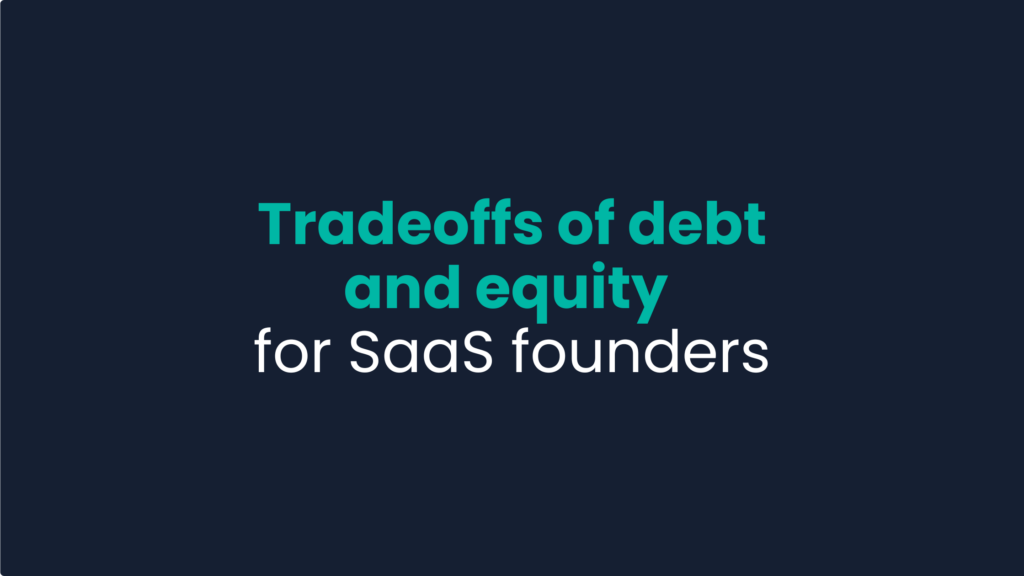Here’s a common scenario for bootstrapped entrepreneurs:
- A founder starts a software business, using personal savings to fund the business.
- After a year or two, it grows enough so that they can start drawing a salary.
- The company grows steadily for 1-10 years.
- The founder sees potential for rapid growth but needs cash to achieve their goals.
- They opt for a small loan to fuel expansion.
- After the initial interest-free year, loan payments begin to strain monthly cash flow.
- Now, the founder’s business is thriving with $5-10m in ARR, but hampered by these repayments.
- They still don’t want to give up equity, but maintaining the status quo feels like walking on a treadmill.
Here are some thoughts on how to approach financing your business in this situation.
Think about matching the risk of the project to the cost of the capital. If you sit down and map out your needs for the next 1-3 years, you should be able to place each item into buckets based on the risk of the project. For example, you might be considering hiring a new marketing person and an SEO agency. Or you might be thinking about hiring two more engineers to build out a feature that a lot of customers have been asking for.
Highly risky things, like entering a new market, probably should be financed with new equity. If it doesn’t work out, you don’t have strict requirements to make payments. But less risky things, like spending more per month on an advertising channel that’s already working, might be a reasonable fit for debt financing. The important thing is to match the risk of the project with the capital that suits that risk.
Any kind of financing comes with tradeoffs. Debt comes with covenants — rules on the kinds of activities your firm can partake in, or financial measures you need to maintain. If you already have debt, you should be familiar with these. Common debt covenants might be that you send quarterly financials to the lenders, or that you keep your net income above a certain threshold relative to the interest payments.
While these debt covenants are restrictive, equity holders come with their own limitations. Lenders will never tell you which product to launch or sales person to hire. They won’t tell you if your strategy isn’t going to work. For better or worse, equity holders will do these things. They own a part of the business and will likely have a perspective on how it’s run. In many cases, this is a good thing—in fact, it should be one of the reasons you raise equity. If you raise from the right people, their perspective will be an asset. But selling equity in your business does bring a new perspective.
Size impacts your available options. The size of your business (measured in ARR) will determine the types of financing available, for both debt and equity.
On the equity side, there are two hurdles. The first is around $3-5m in ARR and the second is around $10m ARR. Anything below the first hurdle ($3-5m in ARR) is going to have trouble finding equity capital. There are very few minority growth investors at that level and it’s also typically too small for buyout funds (even as an add-on). If you’re in between $5-10m in ARR, you have some flexibility. In recent years, the amount of funds doing both minority and majority deals has dramatically increased. And of course, if you are over $10m in ARR you have nearly every fund knocking on your door.
On the debt side, you have more options. In the small stages (<$3m in ARR), there are some lenders specifically focused on underwriting bootstrapped software businesses. You can raise $250-$2m in financing. Once you move into being a larger company (over $10m in ARR), more traditional banks and lenders will lend to you, especially if you’re highly profitable.
Either way, it’s hard to change your revenue quickly, so your size will be one of the first qualifiers for the type of transaction you can do.
Consider alternative financing. While equity and debt are the most well-known categories of financing, there are many others. This is true particularly for SaaS companies: the last cycle brought about many new kinds of companies providing funding for every aspect and size of software businesses.
There are a few examples of this: revenue-based financing, non-bank cash flow lending, and venture debt. Revenue-based financing allows you to repay based on a percentage of your monthly revenue, providing flexibility during slower periods. Non-bank cash flow lenders often offer more lenient terms and faster approval compared to traditional banks. Venture debt combines elements of debt and equity, usually involving interest payments and warrants, offering growth capital without immediate dilution. Each of these options can be tailored to fit your specific business needs and growth trajectory, making them viable alternatives to traditional financing.
Take the long-term perspective. While the instinct may be to avoid diluting your equity, this short-term thinking might kneecap your company long term. By partnering with a growth equity or private equity fund, you not only get capital, but also someone who can help build your business. They know how to scale a business 3-5x, and while you’ve done a great job getting it to the point it is now, at each level of scale you’ll face different challenges. Their involvement can also signal credibility to potential customers, opening up further growth. A partner gives you an even better shot of building something larger.
Another way to think about this is: if you raised debt financing and it helped you grow from $4m to $7m, and you now have to (want to?) take on an equity partner, the debt may have served its purpose. It helped you grow into a larger business, and when you sell your equity now, you’ll be diluted less than if you tried to raise when you were smaller. That’s a win, even if the next move is to make the jump to giving up some equity.

